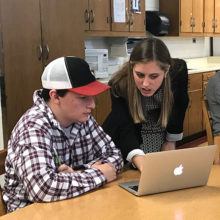
Earlier this month, the RAND Corporation and RTI International released an evaluation of North Carolina’s Pathways from Prison to Postsecondary Education Project, a five-year program designed to help incarcerated individuals obtain a postsecondary degree or credential. The evaluation provides important lessons for both North Carolina and other states looking to implement prison-based postsecondary education programs.
In 2013, North Carolina was one of three states selected to participate in the Vera Institute of Justice’s Pathways from Prison to Postsecondary Education Project. Supported by five national foundations, the project’s goal was to build a prison to postsecondary education pathway that enabled participants to take up to two years of college classes in prison and provided reentry supports to continue that education for two years after their release. Each state received up to $2 million in funding to implement the project.
Along with funding the project, Vera also funded evaluation of the project in each state. Through site visits, interviews, and focus groups, RAND and RTI sought to understand the implementation of the program, the experiences of students, instructors, and prison staff, and what factors helped or hindered the project goals and implementation. The report released earlier this month looks specifically at North Carolina’s experience from the in-prison component to community reentry.
Overview of the Pathways Program
The North Carolina Department of Public Safety’s (NCDPS) Office of Reentry Programs and Services partnered with NCDPS Community Corrections and the North Carolina Community College System (NCCCS) to implement the Pathways Program.
For the in-prison component, participants were moved to six correctional facilities across the state, where they took classes from local community college professors. Students could take courses to earn a certificate, a diploma in general education, or an Associate of Applied Science (AAS) degree in business administration, IT, or entrepreneurship. The in-prison education component lasted anywhere from less than a year to two years.
Upon release, participants received up to two years of reentry support to help them navigate the college enrollment process, find housing, find employment, and in general navigate the stress of returning to society. Prior to Pathways, North Carolina had little in the way of reentry supports.
“It was just kind of like they got released,” said RTI’s Program Director of Adult and Career Education and report co-author Michelle Tolbert. “They had their probation officer, but there really wasn’t a comprehensive system of support for these individuals who got out.”
Because of this, North Carolina selected three communities to which participants would be released: Charlotte, Asheville, and Greenville. These communities were selected because they had community colleges and the necessary infrastructure to support the reentry process, although it also meant that many participants had to live far from their families.
To be eligible to participate in the Pathways Program, North Carolina had several requirements: have a high school credential (diploma or GED), be college ready according to an assessment, be within two years of release, have no gang involvement, and be willing to transfer to a different facility and sign a behavior contract.
Tolbert, who conducted many of the interviews and focus groups in the prisons, said despite the requirements, many participants still needed some developmental education.
“They typically had dropped out of high school sometime prior to getting incarcerated, so they [were] on a road to not having an education,” Tolbert said. “And then once they got incarcerated, they realized that education is probably going to be their ticket to change in their life.”
In total, 165 Pathways students were released from prison to the three communities, and as of August 2018, two students had earned certificates, five earned Associate in Arts degrees, and eight earned Associate in Applied Science degrees.
Although the five-year project timeline is over, North Carolina has continued funding components of the Pathways Program and has developed a statewide reentry action plan building on lessons learned from Pathways.
Lessons learned
The key findings and recommendations from the report provide lessons for North Carolina as it considers how to improve and possibly scale this statewide. In an interview, Tolbert highlighted the importance of the ability of students to earn degrees beyond an Associate in Applied Science, clear communication, buy-in from NCDPS leadership, and a comprehensive system of reentry support.
North Carolina state law limits inmates to taking classes towards an Associate of Applied Science degree, which limited the types of courses and degrees participants could pursue. Upon release, some participants decided to change course entirely, which meant that the credits they earned while incarcerated did not necessarily apply to the degree they wanted to pursue after release. One solution, Tolbert suggested, is to offer more general education courses in prison that translate to a wider array of degrees and credentials.
“The other thing that they could do, and that they were trying to do, is make sure they get all their general courses that almost every community college student has to take under their belt and done before they’re released,” she said. “That way, they can then go any direction they wanted to once they were released.”
Another issue Tolbert spoke to was the importance of clear communication from top to bottom across NCDPS and the community colleges. Because North Carolina was trying to roll out this program very quickly, everyone was not always on the same page, leading to inconsistent information being communicated to participants and creating a sense of uncertainty and distrust among participants.
“The students would hear things, and it would get kind of caught up in the rumor mill, and then they would hear that this incentive or that incentive for them to participate in the program had been taken away from them,” Tolbert said. “And the people that they were having to see on a daily basis were the faculty, and they didn’t know the full story.”
Tolbert went on to say, “So I think North Carolina definitely learned from that experience — that the information about the program and how it’s being pushed out can’t just be kept at the top … but really needs to be a continual flow of communication from top to bottom.”
Tolbert also stressed the importance of buy-in from senior leadership in NCDPS.
“I think that was a really critical piece for North Carolina,” she said. “The fact that the department itself put such a priority on this initiative and really threw themselves into it knowing that it was going to only help them in the long run to figure out how to do this reentry piece better.”
Specifically, Tolbert described that the senior administrator who was in charge of the program was critical in enabling changes to be made when necessary and engendering the respect of the correctional facility wardens.
Finally, one of the biggest lessons learned through the program was the importance of a comprehensive system of support for students during the reentry process. This program allowed NCDPS to see how difficult the reentry process is for people — and how difficult it is to be a full-time student on top of that.
The report describes the challenging reentry process: “Within a few weeks of being released, the students were expected to enroll in college full-time; secure part-time employment; find suitable housing arrangements; address transportation needs; reunite with family members; and, in some cases, resume parental and financial responsibilities for their families while managing and seeking treatment for any substance abuse, depression, anxiety, or other mental health issues.”
One of the community college adminstrators that Tolbert and her colleagues interviewed said, “They’re dealing with all the issues that any young adult is dealing with that’s in a community college, but they’re dealing with it all at once.”
In addition, some of the students had been incarcerated for over a decade. One student Tolbert interviewed had been incarcerated for 19 years. “They just didn’t know if they were going to make it once they got out,” she said. “They had no idea what they were getting themselves into.”
A crucial part of the reentry process turned out to be the Pathways navigator, a person assigned to each student after release who helped them enroll in classes, navigate the financial aid process, find housing and transportation, and whatever else they needed.
“We did hear from a number of students that they don’t think they would have made it and actually enrolled had it not been for that [Pathways navigator] because they had never been on a community college campus before,” Tolbert said.
While the Pathways Program is now over, North Carolina is taking many of these lessons learned and improving the reentry process for all individuals, as outlined in the reentry action plan. Explore the rest of the findings and recommendations in the full report, available here.
Recommended reading



